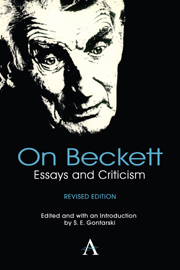Book contents
- Frontmatter
- Contents
- The Essential Beckett: A Preface to the Second Edition
- A Beckett Chronology
- Acknowledgments
- Crritics and Crriticism: “Getting Known”
- Preliminaries
- The Page
- Murphy and the Uses of Repetition
- Watt
- Mercier and Camier: Narration, Dante, and the Couple
- Molloy's Silence
- Where Now? Who Now?
- The Voice and Its Words: How It Is
- The Unnamable's First Voice?
- Between Verse and Prose: Beckett and the New Poetry
- Worstward Ho
- The Stage
- Coda
- Notes on Contributors
Where Now? Who Now?
from The Page
Published online by Cambridge University Press: 05 May 2013
- Frontmatter
- Contents
- The Essential Beckett: A Preface to the Second Edition
- A Beckett Chronology
- Acknowledgments
- Crritics and Crriticism: “Getting Known”
- Preliminaries
- The Page
- Murphy and the Uses of Repetition
- Watt
- Mercier and Camier: Narration, Dante, and the Couple
- Molloy's Silence
- Where Now? Who Now?
- The Voice and Its Words: How It Is
- The Unnamable's First Voice?
- Between Verse and Prose: Beckett and the New Poetry
- Worstward Ho
- The Stage
- Coda
- Notes on Contributors
Summary
Who is doing the talking in Samuel Beckett's novels, who is this tireless “I” constantly repeating what seems to be always the same thing? What is he trying to say? What is the author looking for—who must be somewhere in the books? What are we looking for—who read them? Or is he merely going around in circles, obscurely revolving, carried along by the momentum of a wandering voice, lacking not so much sense as center, producing an utterance without proper beginning or end, yet greedy, exacting, a language that will never stop, that finds it intolerable to stop, for then would come the moment of the terrible discovery: When the talking stops, there is still talking; when the language pauses, it perseveres; there is no silence, for within that voice the silence eternally speaks.
An experiment without results, yet continuing with increasing purity from book to book by rejecting the very resources, meager as they are, that might permit it to continue.
It is this treadmill movement that strikes us first. This is not someone writing for beauty's sake (honorable though that pleasure may be), not someone driven by the noble compulsion many feel entitled to call inspiration (expressing what is new and important out of duty or desire to steal a march on the unknown).
- Type
- Chapter
- Information
- On BeckettEssays and Criticism, pp. 111 - 117Publisher: Anthem PressPrint publication year: 2012
- 1
- Cited by



